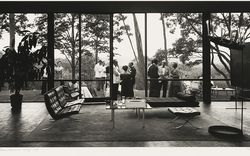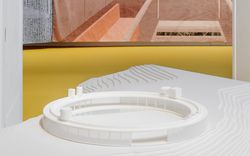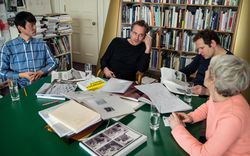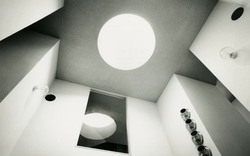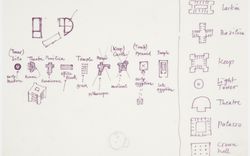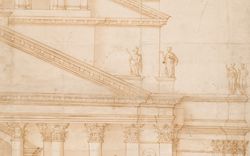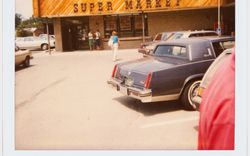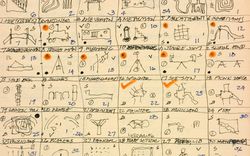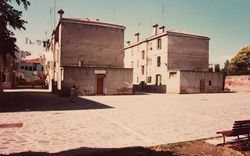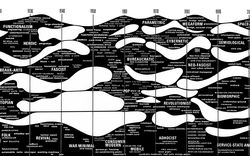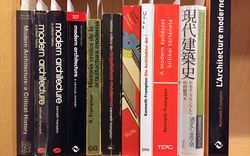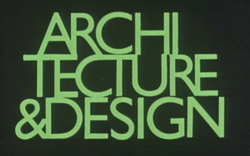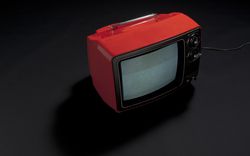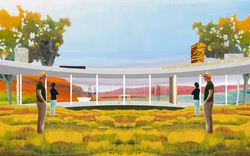What Was History for Kazuo Shinohara?
An adapted Q&A with David B. Stewart
- Question
- In your lecture, you gave examples of a few things that Shinohara was looking at—the urban house in Tokyo, the dense area around Shibuya station, the space shuttle… You also said he liked Mies. But in different periods, we see references to different things. Can you say a little bit more about what he was studying or looking for in these sources?
- DS
- Well, his references evolve throughout the course of his career. He said that he didn’t want to compare himself to Picasso: you know, a rose style and blue style and so forth. But his career is defined by a series of styles that came into being in the course of his research, without him being aware of when the change would happen.
His original research looked at vernacular Japanese architecture and village design. In his early work, he seems not to be paying much attention to the city, but of course he had it in mind. The older Japanese architects expected that Tokyo would somehow be rebuilt after the destruction of the war, with a Beaux-Arts plan or something. Obviously, that didn’t happen.
Japanese could not easily travel after the war because there was rigid exchange control, so people were looking at pictures. Very few Japanese had actually seen Mies van der Rohe’s work, but they could see it through magazines, obviously. A few people went abroad. [Fumihiko] Maki is a famous example because he had a Graham Foundation travelling scholarship. Shinohara’s own teacher somehow arranged to go to Cambridge, Massachusetts, to work for Gropius for several months. But in general, looking was a big deal. When I met Shinohara, however, he never bought books about architecture. It was always books about something else—art, or something. He was completely fascinated by lunar module equipment of all types, and by this NASA Tomcat fighter. He was very attentive to his surroundings, and Tokyo, of course, was being rebuilt and evolving all this time. There was a great deal of comparison with the West.
To go back to the early work, though, Shinohara’s interest in vernacular Japanese architecture and village design is clear in the Umbrella House, from 1961. The roof and the apparent ceiling of this house are not directly characteristic of the vernacular—they are more of a metaphor for an oiled-paper Japanese umbrella.
The plans in Shinohara’s early work are severely compact and functional, although the square shape that is so often a feature in his buildings is non-traditional. According to Shinohara, spaces in Japanese buildings were divisional, not additive. This changes to some extent by the mid-seventeenth century, but by that time additive spaces are usually contained in separate pavilions. This is clearly not the case here, or anywhere else in Shinohara’s oeuvre. He’s trying to secure and neutralize Japanese tradition, in a way.
When I arrived in Japan, in 1974, Shinohara’s work began to be largely based on the constraints of a site, or the construction process, or both. The Tanikawa House is a relatively uncomplicated timber structure—almost barn-like, you could say—but it is built on a slope that covers nine metres in the course of a 1.2-metre ascent.
The client was a well-known Japanese avant-garde poet—he’s also the translator of Charles M. Schulz’s Peanuts cartoons. He asked Shinohara to provide a summer or meditation space. What’s unusual is the fact that, in the summer space, the natural earth of the slope is left completely unfloored. It is not the vernacular packed earth mixed with lime that occurs in pre-modern Japanese houses. It’s simply a barren slope—and actually, in the summer, you get a few little weeds growing. The surrounding landscape is transformed into an architectural space, which is one of the things, for example, that you see Besides, History with Go Hasegawa’s House in the Forest.
The references to the technologies that interested him—the fighter jets, the space shuttle—come in more directly in the final phases of his work. Shinohara was deeply impressed by the supersonic twin-engine F-14 Tomcat fighter developed by Grumman and first deployed in 1974, for example—which he liked for its clumsy efficiency, its lack of the typical smoothness of an aircraft. You can see this influence in Centennial Hall at Tokyo Tech, which he designed in the mid-1980s.
Centennial Hall was one of Shinohara’s first non-residential or public buildings, and it’s a controlled or domesticated version of Tokyo’s urban chaos. It’s less about space than structure and shape, with its oblique-angled fourth level, which was originally imagined as—literally—a cylindrical volume floating above trees.
But even if this phase of work starts to directly engage technology and the city, Shinohara was a fierce anti-Metabolist. He saw Metabolism as a purely economic formation, a translation of revived economic conditions into lifestyle. It paid overt attention to the linear city and to megastructures and so forth, but it didn’t really solve much, I would say. Shinohara was working on a micro level. He felt that people had the right—and this is certainly clear in the first two phases of his work—to have their own emotional space in places where they lived, and that that was somehow disappearing from Japanese culture. So he was open to any images that he thought would advance that, or would gain back some of the territory that he felt was being lost.
Shinohara liked to borrow words or make up like slogans, like “zero-degree machine” or “progressive anarchy,” and these had real meaning given the context of the times. Even though these ideas may sound purely conceptual, they were actually a reaction to what was going on, and oddly enough, he became very optimistic about new technology, just as Tange had been. Tange’s interest in cybernetics is extremely early, and the Metabolists were interested in techno-imagery, but I don’t think they really had much idea of what was involved. At least that’s my take.
Read more
- Question
- You mentioned Go Hasegawa’s connection to Shinohara, through [Kazunari] Sakamoto and [Yoshiharu] Tsukamoto. How would you describe this lineage, or what is characteristic of what passes from one architect to another?
- DS
- Well, we have a sort of Tree of Jesse at Tokyo Tech—so and so begat so and so—and it extends for four or five generations within what is a very small school of architecture. In Japan, or for that matter in China and in most of Asia, the relationship of disciple and master is very important, and in the school it becomes a lifetime relationship.
You have these research units or study units, which are called labs and behave more like a lab in the in the hard sciences, because they’re a physical place. In the fourth year, students are chosen by the other students, and then they practically live there for a whole year—more, if they do post-graduate work. It’s different, surely, from Western schools, and the only trouble is that sometimes the labs are too cloissonné. They’re separated from one another, and students may not have as much contact with other professors.
Hasegawa, like anybody else, is very aware of his relationship with Yoshi Tsukamoto, and these relationships persist. In the West, they probably persist more often in an office than in a school. Of course, at Tokyo Tech, it happens in the architecture of the school, too: Tsukamoto reworked the kitchen of Shinohara’s Centennial Hall. Kitchens were never a strong point of the zero-degree machine. There was only so much Tsukamoto could do, given its shape and access.
Beyond these more direct or personal connections, I might say that Hasegawa shares the kind of distanced agnosticism toward history that is present in Shinohara’s later work—which is why it’s interesting that he is a student of Shinohara, twice removed. For me, this agnosticism is a major theme of the exhibition. - Question
- Can you tell us a bit more of the influence of mathematics on Shinohara’s work?
- DS
- That’s a good question—the relationship is so unusual. Shinohara was originally trained as a mathematician. He was not drafted, and at the very end of the war, he went to Korea for training for six weeks, but then the war ended, fortunately. So he was able to continue his studies in mathematics. He taught for a few years before he came to Tokyo Tech and retrained as an architect.
I think the most clear connection between his studies in mathematics and his architectural work relates to the idea of topology. Unlike most architects, he had enough of a mathematical background to articulate his interest in it. For ordinary people, just there’s no way that you can just sort of brush up on your topology. A lot of people throw the term around, and there are certain examples—like the Möbius strip—that we all know, but he was very keen on figures and on angles, particularly roof angles. That’s, of course, what the zero-degree machine thing is about, which is taken via [Koji] Taki, the historian and photographer who was also a philosopher, from Roland Barthes—the idea that language and literature and writing are all very different activities. He was always trying to get rid of extraneous meaning. You can read his background in mathematics into a few of his remarks—that the pillars are only pillars or the wall is only a wall. He could consider the elements of the building as pure mathematics, if he wanted to turn that optic on, I would say. - Question
- Could you talk a bit more about Shinohara’s notion of history? Is there something specifically Japanese about it?
- DS
- His interest in history, I think, was strictly operative or instrumental. Tafuri, of course, uses the word “operative” in a sort of negative way, but before that, it was a different story. There was a movement after World War II in Japan called The Debate on Japanese Tradition, which crossed the boundaries of art, literature, painting, architecture, and I think it must have had some influence on Shinohara’s move from mathematics to architecture. He had also toured some of the old buildings of Kyoto and Nara, some of the large religious establishments that are really, really old and really, really impressive. These are buildings that were probably not actively used in the middle of the war, but students would be taken on trips—not architectural students, but middle- or high-school students—to see them. He was old enough to get the full impact of those visits, and he always brought the notion of deep personal emotion into his architecture. He didn’t talk about that much, but he certainly wrote about it.
Shinohara realized that after the war you couldn’t just pick up tradition where things had broken off. One of his aphorisms was, “Tradition may be a point of departure for creation, but it’s never a way back.” Much of Japan was modernized before World War II, and I think he was also interested in playing off the new modernism that Japan was able to achieve after the the vast destruction of Tokyo. These emotional needs that he perceived everybody had could be fulfilled in residential architecture, and he concentrated purely on residential architecture for the first twenty years of his practice, I guess, but he was always aware of the city and the city’s growth behind that.
He perceived this as a real problem. Where do we go from here? What’s the next move? It’s hard to think of that today, because we can build anything. After World War II in Japan, it was quite a while before good materials were available again—and this was true in Europe as well. Shinohara’s first house is a take on Kenzō Tange’s own house. Tange, like Maki, only built one house and that was for himself. That first house is a combination of Tange’s house, which he would pass every day on his way to school while it was under construction, and Mies van der Rohe, I would say. And the steel pillars in that project are very curious: they’re C-section pillars filled with cement or concrete, because that was the best that was available.
But anyway, I think history for Shinohara was right catch-as-catch-can, right from the beginning: how do we deal with this? How do we use history? How can we achieve our goals? It wasn’t just a side issue.





We invited David B. Stewart here to answer this question in the context of the exhibition Besides, History: Go Hasegawa, Kersten Geers, David Van Severen.
